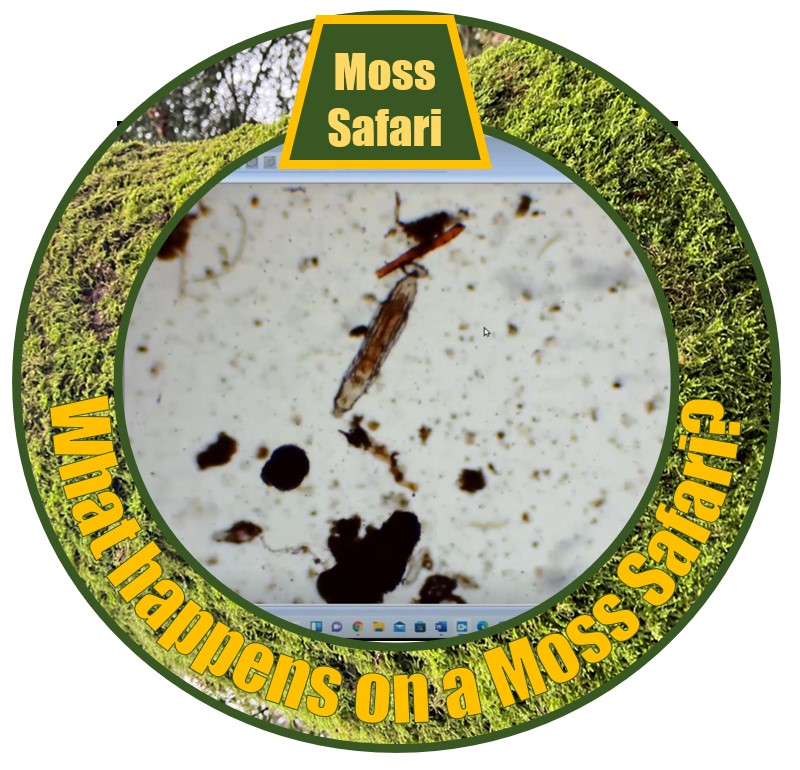
If you haven’t seen a live Moss Safari online you might be wondering what happens and what all the fuss is about. This blog is for you. In the past two weeks I have done two Moss Safaris online. One as part of a World Microscopy Day event hosted by Quekett and another for the Association for Science Education. Here I report the highlights and outcomes of both events.
The premise
Moss Safari is an adventure through the microscopic world of moss. People who are interested join me on a Zoom (or similar channel) from the comfort of their own home, from their place of work, or from a classroom. I introduce you to what to expect on a Moss Safari, then I squeeze the water out of some moss that I have collected from my garden. We then switch to the camera that I have on my microscope and we observe the life from within the moss that is on the microscope slide.
World Microscope Day
This is an amazing event over 24 hours with presentations from enthusiasts from all over the world. I have to say I felt a bit nervous about presenting to an audience, most of whom were much more experienced than me.
However, the unique aspect of Moss Safari is it’s underlying pedagogy, which is curriculum linked and takes into account aspects for drawing complete novices into at least appreciating the microscopic world on their door step and hopefully venturing into their own use of a microscope.
The feedback from the 44 or so participants was encouraging and positive. I also had the pleasure of watching other sessions from enthusiasts and experts from the UK, Russia and the USA. I am hoping to catch up on the videos of the sessions that I missed, which are slowly being uploaded here, including the Live Moss Safari. Thanks to Robert Ratford for inviting me and organising this amazing event.
Live and online for the family hosted by ASE
This is the second year I have hosted a Live and Online Moss Safari for the ASE. This year we had a great audience of 35 people, mostly science technicians, but also so teachers and other folk from science education.
This particular Safari only yielded two of the big five, the rotifer (in various ‘modes’, including after a bit of patience, a rotifer opening her wheel organs and feeding) and a thrashing nematode. However, we did see some unicellular marvels including a number of active testate amoeba, diatoms and ciliates. We observed one busy ciliate in the act of excretion – removing waste from it’s body, which was a highlight for some.
This audience were extremely enthusiastic and had many questions. I always ask participants to complete a short evaluation at the end of a session to get a feel for their reaction and to inform future Moss Safaris. Of the 16 that responded, all agreed that they enjoyed the session, found it interesting and learnt something new. All were inspired to a Moss Safari on their own. In addition two thirds said it made them consider buying a microscope for themselves or someone else.
It’s always interesting to read people’s feedback on their experience from Moss Safari. Three people suggested a bank of videos that shows the organisms in different ‘modes’ so people new to Moss Safari know what to look for or so that if we don’t get to see an organism live, we can see a recording of it. I think this is a great idea and will put something together over the summer.
Others feed back:
More time!
I would love a part 2 – where we take images and share them discussing what we found
More anecdotes and amazing facts – students love that kind of thing – they also help to tie the activity in to the curriculum eg ecology, pollution, environmental issues
Possibly with a book to go alongside 🙂
A week later it was lovely to see this comment on Twitter.

If you would like to experience an online Moss Safari for your school or organisation, do get in touch.
To join a live online Moss Safari, follow us and look out for updates on Twitter @mosssafari Facebook https://www.facebook.com/mosssafari or Instagram @moss_safari